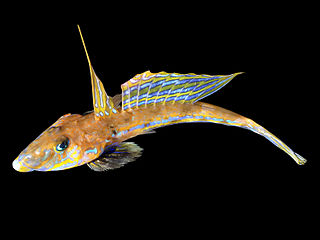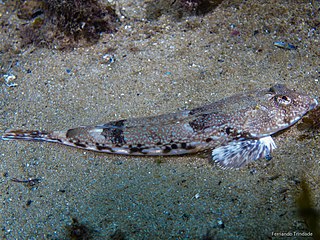
Callionymus is a genus of dragonets found mostly in the Indian and Pacific oceans with a few species occurring in the Atlantic Ocean.

Callionymus bairdi, the Lancer dragonet, Baird's dragonet, coral dragonet or St Helena dragonet, is a species of dragonet native to the warmer waters of the Atlantic Ocean where it occurs at depths of from 1 to 91 metres. In the western Atlantic it occurs from Cape Hatteras southwards along the east coast of North America. including Bermuda and the Bahamas, into the Gulf of Mexico and throughout the Caribbean Sea. It has also been recorded from Ilha da Trindade off Brazil. In the eastern Atlantic it has been recorded from the Cape Verde Islands, Ascension Island, St. Helena, and Sao Tome e Principe in the Gulf of Guinea. This species grows to a length of 11.4 centimetres (4.5 in) TL.
Callionymus bentuviaiBen-Tuvia's deepwater dragonet, is a species of dragonet endemic to the Red Sea. This species grows to a length of 6.3 centimetres (2.5 in) SL.
Callionymus draconis, the Japanese spiny dragonet, is a species of dragonet native to temperate regions of the Indian and Pacific oceans around Japan and western Australia where it occurs at depths of around 138 metres (453 ft). This species grows to a length of 9 centimetres (3.5 in) SL.
Callionymus enneactis, the mangrove dragonet or common dragonet, is a species of dragonet native to the western Pacific Ocean at depths down to 15 metres (49 ft). At shallower depths it occurs in areas of mangroves, being found on coral reefs at deeper depths. This species grows to a length of 8 centimetres (3.1 in) TL.
Callionymus gardineri, the longtail dragonet, is a species of dragonet native to the western Indian Ocean. It can be found at depths of from 30 to 180 metres. This species grows to a length of 28 centimetres (11 in) TL. The specific name honours the British zoologist John Stanley Gardiner (1872-1946).
Callionymus hildae, Hilde’s darter dragonet, is a species of dragonet endemic to the Pacific waters around the Philippines. The specific name honours Miss Hildegard Handermann, of Braunschweig, for her "continued interest" in the author's, Ronald Fricke's, studies.

Callionymus japonicus, the Japanese longtail dragonet, is a species of dragonet native to the western Pacific Ocean where it is found at a depth of around 208 metres (682 ft). This species grows to a length of 20 centimetres (7.9 in) SL.
Callionymus leucobranchialis, the Whitegill dragonet, is a species of dragonet found in the Pacific waters around the Philippines at a depth of about 82 metres (269 ft).

The common dragonet is a species of dragonet which is widely distributed in the eastern North Atlantic where it is common near Europe from Norway and Iceland southwards. It is a demersal species that occurs over sand bottoms. It lives to a maximum age of around seven years. It is caught in bycatch by fisheries and is used in the aquarium trade.

Callionymus pusillus, the Sailfin dragonet, is a species of dragonet common in the Eastern Atlantic, where it occurs on the Portuguese coast to as far north as Lisbon and south to Morroco, and also in the northern Mediterranean including the Adriatic, Aegean and Black seas as well as the coastsLebanon and Israel. It occurs on the southern Mediterranean shore as far east as Tunisia Males of this species grows to a length of 14 centimetres (5.5 in) TL while females reach a length of 10 centimetres (3.9 in) TL. In the areas of the Mediterranean where it occurs it is one of the commonest dragonet species, as it is the only species that has been recorded within many protected areas. It is a benthic species which occurs in shallow waters and prefers sandy bottoms down to 100 metres (330 ft). The males are territorial, aggressively defend their territories from other males and like other dragonets this species undergoes complex breeding behaviour which has 4 phases. This starts with courtship, the male and female then form a pair before ascending to the surface where they release eggs and milt. The spawning season runs from May to August in the Mediterranean and the eggs and larvae are pelagic. This species feeds mainly on small benthic invertebrates such as worms and small crustaceans.

Callionymus reticulatus, the reticulated dragonet, is a species of dragonet native to the northeastern Atlantic Ocean and the Mediterranean Sea where it is found at depths of from 0 to 110 metres. This species grows to a length of 11 centimetres (4.3 in) TL. This species has a flattened head and body, the head has a triangular shape with the eyes placed on the top of the head. It has two dorsal fins with the first one being triangular in shape. It has blue spots along the flanks and four saddle-like markings on their backs which have sharply defined outlines. It is similar to the common dragonet but is distinguished by its smaller size and the sharply defined border around the saddle markings on the back.

Callionymus risso, Risso's dragonet, is a species of dragonet native to the Mediterranean Sea as well as the Black Sea and rarely found off of Portugal in the Atlantic Ocean. This species can be found at depths of from 15 to 150 metres. Males of this species grows to a length of 11 centimetres (4.3 in) TL while females reach a length of 6.5 centimetres (2.6 in).

Arrow dragonet, also known as the arrow-headed darter dragonet, is a species of dragonet widespread in the Indo-West Pacific from Arabian Peninsula to the Philippines. Occurs in the Mekong delta of Viet Nam and probably also in Cambodia. This species grows to a length of 11 centimetres (4.3 in) TL. The arrow dragonet is a demersal species, which occurs on sandy substrates along coastlines, in estuaries, and in the lower courses of rivers where it feeds on worms, zooplankton and phytoplankton.
Callionymus schaapii, the Short-snout sand-dragonet, is a species of dragonet native to the eastern Indian Ocean and the western Pacific Ocean where it is found at a depth of around 8 metres (26 ft). It prefers muddy or sandy substrates, preferring areas near river mouths or estuaries. This species grows to a length of 6.5 centimetres (2.6 in) TL.
Callionymus stigmatopareius, the Mozambique dragonet, is a species of dragonet only known from the Indian Ocean off of Mozambique.
Callionymus sublaevis, the Australian filamentous dragonet, is a species of dragonet native to the southwestern Pacific Ocean. It is popular as a gamefish. This species grows to a length of 14.3 centimetres (5.6 in) TL.
Callionymus superbus, the proud dragonet or superb dragonet, is a species of dragonet native to the western Pacific Ocean where it occurs down to depths of 25 metres (82 ft). This species grows to a length of 20 centimetres (7.9 in) TL.
Callionymus whiteheadi, Whitehead’s deepwater dragonet, is a species of dragonet found in the Pacific waters around Indonesia. The specific name honours the ichthyologist Peter James Palmer Whitehead (1930-1992).








